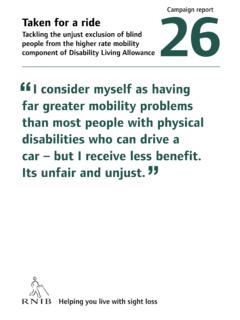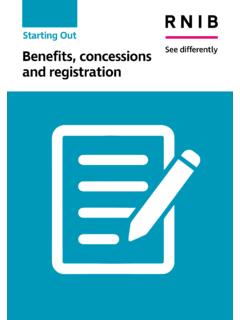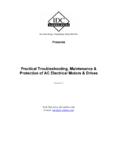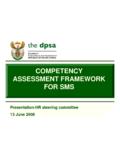Transcription of Understanding your patients’ needs Supporting people with ...
1 Understanding your patients ' needs Supporting people with sensory loss Best-practice guide for GP surgeries 2 Supporting people with sensory loss Contents Definitions .. 2. Foreword .. 3. Summary of legal responsibilities and standards .. 4. Best-practice recommendations .. 6. Access to GP premises .. 6. Accessible communications .. 8. Accessible information and correspondence .. 12. Accessible information requirements .. 13. Training .. 13. Equipment and technology .. 14. Policies and procedures .. 15. Further sources of information and advice .. 17. Appendices .. 19. Minimum standards for clear print and large print .. 19. Fingerspelling alphabet .. 20. Tips to help you communicate with a person with sensory loss .
2 21. Definitions The term people with sensory loss ' refers to: people who are Deaf, deafened or have hearing loss people who are blind or partially sighted people who are deafblind: those whose combined sight loss and hearing loss causes difficulties with communication, access to information and mobility. Supporting people with sensory loss 3. Foreword sensory loss affects one in five of us In Wales, 575,500 people are deaf or have hearing loss , 106,980 are blind or live with sight loss , and 20,786 are deafblind. These numbers will continue to grow as the population ages. people with sensory loss are more likely to feel cut off from their local community, which can lead to loneliness, mental health issues and associated health problems.
3 As healthcare professionals, there is plenty you and your staff can do to help. Much of what we recommend here is not costly. Often, simply changing attitudes and behaviour towards patients who have sensory loss can help. A simple question such as How would you like to communicate with us? can make all the difference. This guide provides practical advice on how to support patients living with a sensory loss . Although aimed at people working in GP surgeries, much of the guidance is relevant to other health settings. The document has been developed by Action on Hearing loss Cymru and RNIB Cymru, following consultations with groups of people with sensory loss in Wales. Their personal experiences are reflected in quotes featured throughout this document, many of them revealing negative experiences.
4 Although we accept that the people who took part in our project are more likely to want to raise an issue than give positive feedback, this shows that there is still work to be done to ensure health providers are Supporting patients with a sensory loss . For further guidance on how best to communicate with patients with sensory loss , you can contact us, RNIB Cymru or any other organisation Supporting people with sensory loss . Their contact details are at the end of this document (see pages 17 18). Richard Williams Director, Action on Hearing loss Cymru 4 Supporting people with sensory loss Summary of legal responsibilities and standards All Wales Standards for Communication and Information for people with sensory loss The All Wales Standards (the Standards), the public should be available in accessible published in 2013, set out the level of formats for people with sensory loss (for service that adults, young people and example large print, audio file and braille).
5 Children with sensory loss should expect when accessing healthcare services All public and patient areas of the practice in Wales. should be accessible to people with sensory loss . In addition, people with The Standards reference the Equality Act sensory loss should be asked to offer their 2010. Under the Act, service providers, feedback on access to the premises and organisations and employers have a any feedback should be used to improve duty to make reasonable adjustments to the levels of access. avoid putting people with disabilities at a substantial disadvantage compared to people with sensory loss should be people who are not disabled. asked to describe their communication needs when registering with a new GP.
6 This includes making changes to provisions, practice; this information should contain criteria or practices, altering physical details of the patient's sensory loss and premises and providing equipment to meet any communication support they might communication needs . require, such as British Sign Language (BSL) interpreters. Surgeries should ensure The Standards also refer to the UN they have up-to-date information for Convention on the Rights of Disabled existing patients . people (UNCPRD), which provides an international standard for disabled people 's By utilising a flagging' system on patient human rights. Effective and appropriate files, practice staff will be able to input communication is fundamental to ensuring practical information on a patient's that all services are delivered in ways that communication and information needs , promote dignity and respect.
7 Which both current and future practice staff can refer to in the future. The Standards state: When patients are referred to secondary All frequently used information leaflets healthcare, their communication and and documents intended for patients and information needs should be included in Supporting people with sensory loss 5. the referral details to ensure the patients continue to receive an accessible service. Clear signage should be used throughout the practice to ensure patients with sensory loss can easily navigate the premises. I am never sure if I. For patients with sensory loss , it is am entering the right important to note the impact that background noise, lighting and colour room, as the door sign contrasting can have on their ability to isn't very clear.
8 Communicate effectively. Article nine, UNCRPD. For further information, and to read the Standards in full, please go to: In addition to the All Wales Standards, Article nine in the UNCRPD states: health/guidance/standards/?lang=en Parties shall also take appropriate measures to provide forms of live assistance and intermediaries including guides, readers and sign language interpreters, to facilitate accessibility to buildings and other facilities open to the public. Why can't they We also recommend reading the Older simply place 'flags' people 's Commissioner for Wales'. on their system to publication, GP Services in Wales: The Perspective of Older people alert them to my sensory loss and pub-story/17-02-28/GP_Services_in_.
9 Wales_The_Perspective_of_Older_People. my requirements? aspx#.WMfLB9 Lyjcs GP surgeries should also take account of the joint publication of the Royal College of General Practitioners, UK Vision Strategy and Thomas Pocklington Trust, Sight loss in older people : The essential guide for general practice. 6 Supporting people with sensory loss Best-practice recommendations Our overarching recommendation, for all healthcare providers, is to actively encourage patients with sensory loss to Tell, Ask and Share. patients should;. Tell GP practices about their sensory loss . Ask GP practices for accessible information and communication, specifying their individual needs . The staff at my These needs should be recorded by the practice.
10 Surgery asked me Share feedback on their experiences what they could do to both good and not so good. help and they make It is good practice to invite people every effort to make with sensory loss to, or involve them in, my visit as pleasant patient participation programmes. as possible.. Our evidence suggests that many primary care health providers are not fully meeting their obligations under the All Wales Access to GP premises Standards and other related legislation. Make sure the physical premises are fully We urge GP surgeries to review their accessible for patients with sensory loss . obligations and make an honest Ensure you consider all aspects of internal assessment of how they are doing before and external areas of the premises.








